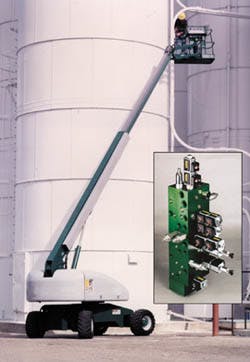Hydraulic manifold key to telescopic boom lift
Hydraulic manifolds bring a host of benefits to the table &emdash; or at least to a machine's hydraulic system. Space savings is usually, but not always, foremost among them. The result is a compact assembly of valves often referred to as an integrated hydraulic circuit (IHC).
Integrated circuitry became commonplace in electronics decades ago. And although IHCs cannot offer nearly the same space savings as today's integrated electronic micro circuits, IHCs can be much more compact than their traditional counterparts, which use line-mounted valves, hose, tubing, and fittings.This list of components brings out another advantage to IHCs: less leakage. Because IHCs use fewer connections, they hold less potential for leakage. Fewer connections also means faster assembly, which can lead to substantial cost savings.
Another big plus is simplified assembly, which not only can lower the likelihood of leakage, but also can improve system reliability. Hand-in-hand with this higher reliability is easier maintenance and troubleshooting. Because so many components are mounted to a common manifold, maintenance technicians often can avoid having to climb all over a machine to test individual components.
Furthermore, when problems do occur on critical equipment, the entire IHC can be replaced with an identical one to minimize downtime. Troubleshooting and repair can then be performed on the faulty IHC, which can become a standby replacement once it has been serviced.
A typical example of an application that takes advantage of these benefits is the self-propelled telescopic boom lift shown. The inset photo shows the IHC, provided by Sterling Hydraulics, Elk Grove Village, Ill., that controls hydraulic fluid flow, direction, and pressure for multiple functions. The hydraulic system operates at pressures to 3,000 psi and controls flow to 9 gpm.
The hydraulic system provides load sensing, which conserves energy by matching output to demand. Priority flow is provided for steering, and three cartridge-style, pressure-compensated proportional valves control all three boom functions. This encompasses up to 6 gpm for boom raising and lowering, up to 9 gpm for boom extension and retraction, and up to 1 gpm for boom swing. The IHC also controls actuators that keep the basket level, and provides an emergency dump function, often referred to as a "dead-man" switch.


